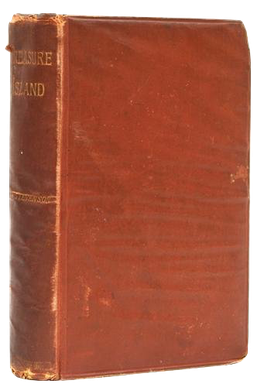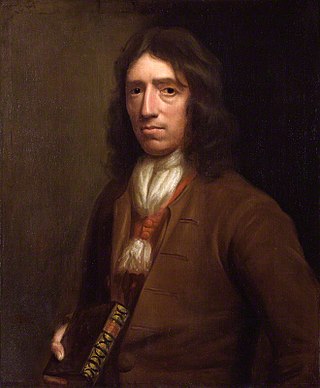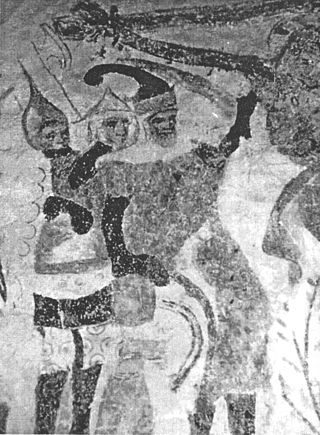
Buccaneers were a kind of privateer or free sailors, and pirates particular to the Caribbean Sea during the 17th and 18th centuries. First established on northern Hispaniola as early as 1625, their heyday was from the Restoration in 1660 until about 1688, during a time when governments in the Caribbean area were not strong enough to suppress them.

Treasure Island is an adventure and historical novel by the Scottish author Robert Louis Stevenson. It was published in 1883, and tells a story of "buccaneers and buried gold" set in the 1700s. It is considered a coming-of-age story and is noted for its atmosphere, characters, and action.

William Dampier was an English explorer, pirate, privateer, navigator, and naturalist who became the first Englishman to explore parts of what is today Australia, and the first person to circumnavigate the world three times. He has also been described as Australia's first natural historian, as well as one of the most important British explorers of the period between Sir Francis Drake and Captain James Cook ; he "bridged those two eras" with a mix of piratical derring-do of the former and scientific inquiry of the latter. His expeditions were among the first to identify and name a number of plants, animals, foods, and cooking techniques for a European audience, being among the first English writers to use words such as avocado, barbecue, and chopsticks. In describing the preparation of avocados, he was the first European to describe the making of guacamole, named the breadfruit plant, and made frequent documentation of the taste of numerous foods foreign to the European palate at the time, such as flamingo and manatee.

Captain Jack Sparrow is a fictional character and the main protagonist of the Pirates of the Caribbean film series and franchise. An early iteration of Sparrow was created by screenwriters Ted Elliott and Terry Rossio, but the final version of the character was created by actor Johnny Depp, who also portrayed him.

John Guy was an English merchant adventurer, colonist and politician who sat in the House of Commons from 1621 to 1624. He was the first proprietary governor of Newfoundland Colony, the first attempt to establish a colony on Newfoundland.

Sir Francis Charles Chichester KBE was a British businessman, pioneering aviator and solo sailor.

ElizabethSwann is a fictional character in the Pirates of the Caribbean film series. She appears in The Curse of the Black Pearl (2003), Dead Man's Chest (2006), At World's End (2007) and Dead Men Tell No Tales (2017). She is portrayed by Keira Knightley in all four films. Elizabeth is the daughter of Weatherby Swann, the wife of Will Turner and the mother of Henry Turner.

The Victual Brothers were a loosely organized guild of privateers who later turned to piracy. They affected maritime trade during the 14th century in both the North and Baltic Seas.

The Life, Adventures and Piracies of the Famous Captain Singleton is a novel by Daniel Defoe, originally published in 1720. It has been re-published multiple times since, some of which times were in 1840 1927, 1972 and 2008. Captain Singleton is believed to have been partly inspired by the exploits of the late 17th century English pirate Henry Every.

Pirate Adventure is a text adventure video game written by Scott Adams. It was published by Adam's company, Adventure International, in 1979.

The Pirate is one of the Waverley novels by Sir Walter Scott, based roughly on the life of John Gow who features as Captain Cleveland. The setting is the southern tip of the main island of Shetland, towards the end of the 17th century, with 1689 as the likely date of the main incidents.

In English-speaking popular culture, the modern pirate stereotype owes its attributes mostly to the imagined tradition of the 18th-century Caribbean pirate sailing off the Spanish Main and to such celebrated 20th-century depictions as Captain Hook and his crew in the theatrical and film versions of J. M. Barrie's Peter Pan, Robert Newton's portrayal of Long John Silver in the 1950 film adaptation of the Robert Louis Stevenson novel Treasure Island, and various adaptations of the Middle Eastern pirate, Sinbad the Sailor. In these and countless other books, films, and legends, pirates are portrayed as "swashbucklers" and "plunderers". They are shown on ships, often wearing eyepatches or peg legs, having a parrot perched on their shoulder, speaking in a West Country accent, and saying phrases like "Arr, matey" and "Avast, me hearty". Pirates have retained their image through pirate-themed tourist attractions, film, toys, books and plays.

The Black Pirate is a fictional character from DC Comics, created by Sheldon Moldoff. He first appeared in Action Comics #23. His ghost played an important role in James Robinson's 1990s Starman series.

Zheng Yi Sao, also known as Shi Xianggu, Shek Yeung and Ching Shih, was a Chinese pirate leader active in the South China Sea from 1801 to 1810.
Captain David Grief is an American action/adventure television series that aired in syndication from October 1957 to 1960. The program was based on a series of Jack London short-stories centered on the South Seas tradesman and adventurer David Grief, collected in A Son of the Sun.

Joseph Allan Elphinstone Dunn, best known as J. Allan Dunn, was one of the high-producing writers of the American pulp magazines. He published well over a thousand stories, novels, and serials from 1914 to 1941. He first made a name for himself in Adventure. At the request of Adventure editor Arthur Sullivant Hoffman, Dunn wrote Barehanded Castaways, a novel about people trapped on a desert island which was intended to avoid the usual cliches of such stories. Barehanded Castaways was serialised in 1921 and was well received by Adventure's readers. Well over half of his output appeared in Street & Smith pulps, including People's, Complete Story Magazine, and Wild West Weekly. Dunn wrote over a thousand stories. He wrote approximately 470 stories for Wild West Weekly alone. His main genres were adventure and western; although he did write a number of detective stories, most of them appearing in Detective Fiction Weekly and Dime Detective. Dunn wrote The Treasure of Atlantis, a science fiction story about survivals from Atlantis living in the Brazilian jungle. The Treasure of Atlantis was published in All-Around Magazine in 1916 and later reprinted in 1970. He was a specialist in South Sea stories, and pirate stories. He also published a lot of juvenile fiction; including many stories for Boys' Life, primarily in the 1920s. A number of his novel-length stories were reprinted in hardbound, some under the pen name "Joseph Montague" for Street & Smith's Chelsea House imprint; many of his books were issued in the United Kingdom. His stories were frequently syndicated in newspapers, both in America and around the world, making him, for a time, a very widely known author.
Tales of the South Seas is a 1998 Australian TV series loosely based on Jack London's 1912 novel A Son of the Sun.

The trident of Poseidon and his Roman equivalent, Neptune, has been their traditional divine attribute in many ancient depictions. Poseidon's trident was crafted by the Cyclopes.















